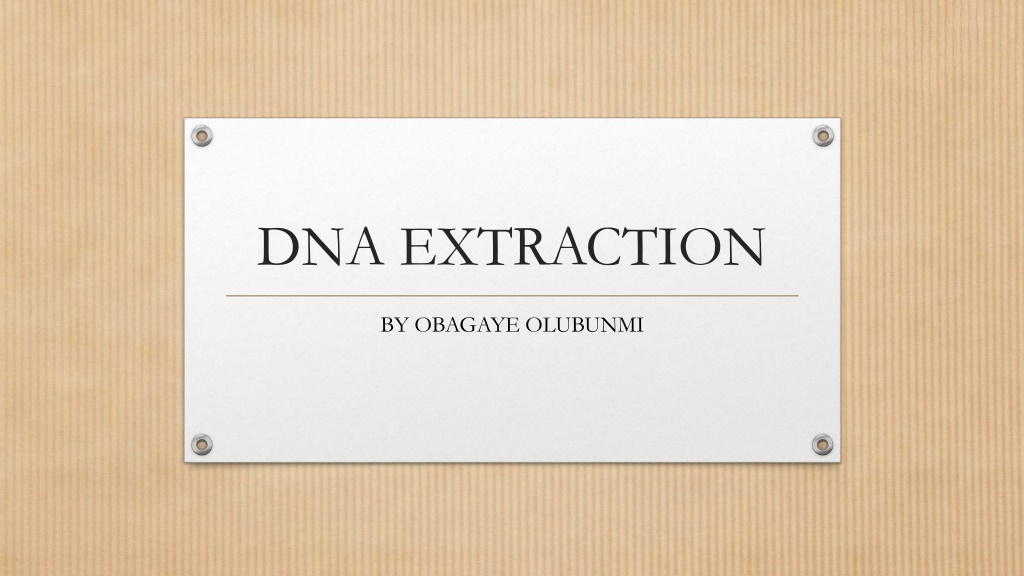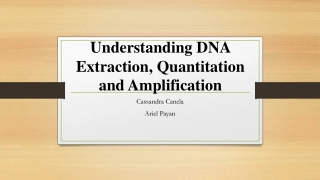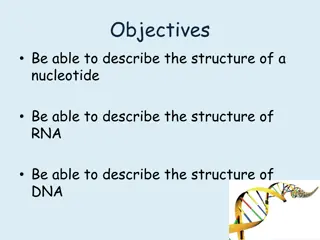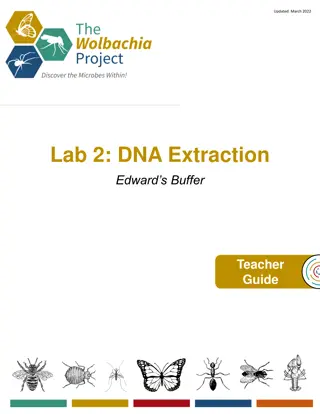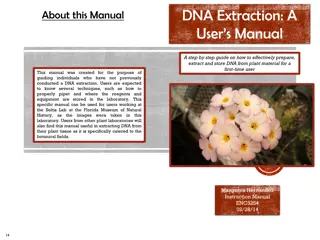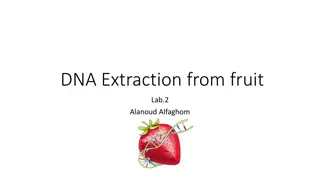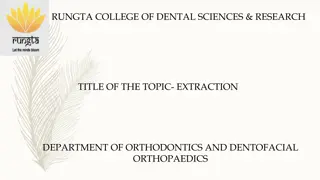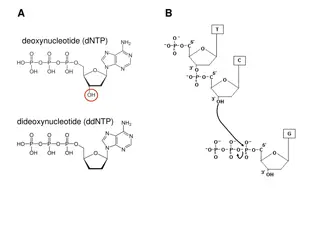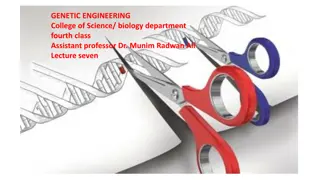Understanding DNA Extraction Process: Steps and Importance
DNA extraction is a crucial process in molecular biology that involves separating DNA from cellular components. The process includes steps like lysis, precipitation, and purification to obtain pure DNA samples. Careful handling and proper labeling of samples are essential to prevent contamination. The content explains the basic steps involved in DNA extraction and highlights the importance of this process in various biological studies.
Download Presentation

Please find below an Image/Link to download the presentation.
The content on the website is provided AS IS for your information and personal use only. It may not be sold, licensed, or shared on other websites without obtaining consent from the author. Download presentation by click this link. If you encounter any issues during the download, it is possible that the publisher has removed the file from their server.
E N D
Presentation Transcript
DNA EXTRACTION BY OBAGAYE OLUBUNMI
Deoxyribonucleic acid (DNA) extraction is the process by which DNA is separated from proteins, membranes, and other cellular material contained in the cell from which it is recovered. The DNA extraction process requires careful handling of biological material to prevent sample contamination and crossover. Tubes should be carefully labelled, especially when transfers are required.
The simplest cells, such as bacteria cells, are prokaryotes. These prokaryotes comprise a lipid bilayer outer membrane and a cytoplasm containing a circular chromosome, proteins, inorganic salts and metal ions, sugar molecules, and other elements of cell machinery. Humans, animals, and plants are composed of eukaryotic cells; these cells also have a lipid bilayer outer membrane and cytoplasm containing proteins, sugars, lipids, and inorganic ions of various types and function. However, eukaryotic cells also contain other membrane-enclosed compartments called organelles. The nucleus of a cell is an organelle that houses 46 chromosomes, and the mitochondria each house a circular DNA chromosome, all of which direct the production of proteins.
Basic Steps in DNA Extraction Lysis Precipitation Purification
STEP 1 - Lysis In this step, the cell and the nucleus are broken open to release the DNA inside and there are two processes involved in this: First, mechanical disruption breaks open the cells. This can be done with a tissue homogenizer (like a small blender), with a mortar and pestle, vortexing or by cutting the tissue into small pieces (depending on the type of sample). Mechanical disruption is particularly important when using plant cells because they have a tough cell wall. Secondly, lysis is completed using detergents and enzymes such as Proteinase K to free the DNA and dissolve cellular proteins. The detergent breaks down the lipids in the cell membrane and nuclei, while the proteinase K dissolves DNA associated proteins and cellular proteins.
STEP 2 - Precipitation After the completion of the lysis step, the DNA has been freed from the nucleus, but it is now mixed with mashed up cell parts. Precipitation separates DNA from this cellular debris. First, concentrated salt such as Na+ ions (sodium) is added, which neutralizes the negative charges on the DNA molecules, thus makes them more stable and less water soluble. Next, ice- cold alcohol (such as ethanol or isopropanol) is added and causes the DNA to precipitate out of the aqueous solution because DNA is insoluble in the presence of salt and alcohol. By gently stirring the alcohol layer with a sterile pipette, a precipitate becomes visible and can be spooled out. If there is lots of DNA, you may see a stringy, white precipitate.
STEP 3 - Purification Now that DNA has been separated from the aqueous phase, it can be washed with alcohol to remove any remaining unwanted material and cellular debris. At this point the purified DNA is usually re-suspended in slightly alkaline buffer ( such as TE buffer or ultra clean water) for easy handling and storage.
Checking for DNA Purity and Quality Optical density readings taken by a spectrophotometer can be used to determine the concentration and purity of DNA in a sample. Measuring the intensity of absorbance of the DNA solution at wavelengths 260 nm and 280 nm is used as a measure of DNA purity. DNA absorbs UV light at 260 and 280 nanometres, and aromatic proteins absorb UV light at 280 nm; a pure sample of DNA has a ratio of 1.8 at 260/280 and is relatively free from protein contamination. A DNA preparation that is contaminated with protein will have a 260/280 ratio lower than 1.8. Alternatively, gel electrophoresis can be used to show the presence of DNA in your sample and give an indication of its quality. DNA can be quantified by cutting the DNA with a restriction enzyme, running it on an agarose gel, staining with ethidium bromide (EtBr) or a different stain and comparing the intensity of the DNA with a DNA marker of known concentration.
What Can This DNA Be Used For? Once extracted, DNA can be used for molecular analyses including PCR, electrophoresis, sequencing, fingerprinting and cloning.
